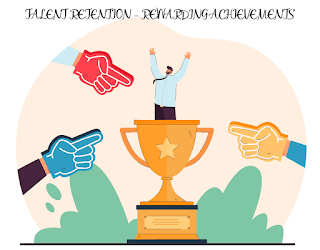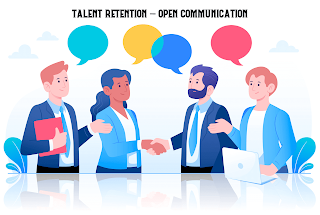The Essential Guide to Talent Retention in Organizations: How to Keep Your Star Employees Happy and Productive
Introduction
In today's competitive business landscape, attracting and retaining talented employees is crucial for the success of any organization. High employee turnover can be both costly and disruptive, leading to decreased productivity and morale. To ensure the longevity and growth of your company, it is essential to have effective talent retention strategies in place.
In this comprehensive guide, we will explore the importance of talent retention, the key factors that influence employee satisfaction and loyalty, and the best practices to keep your star employees happy and productive.
Whether you are a small startup or a large corporation, this guide will provide you with the essential knowledge and tools to build a strong and loyal workforce. Let's dive in and discover the secrets to talent retention success!
The importance of talent retention in organizations
Talent retention is a critical aspect of building a successful and sustainable organization. In today's competitive business environment, where skilled professionals are in high demand, organizations cannot afford to lose their star employees.
Here are some key reasons why talent retention should be a top priority for any organization:
- Cost savings: High employee turnover can result in significant financial losses for organizations. It costs time, money, and resources to recruit, hire, and train new employees. Additionally, the loss of institutional knowledge and expertise when star employees leave can have a detrimental impact on productivity and innovation.
- Continuity and stability: Retaining talented employees provides stability and continuity in the workforce. These employees have a deep understanding of the organization's goals, culture, and processes, and their institutional knowledge is invaluable for maintaining smooth operations. Their departure can disrupt team dynamics and lead to decreased efficiency.
- Increased productivity: Employees who feel valued and appreciated are more likely to be engaged and motivated to perform at their best. When star employees are happy and satisfied in their roles, they are more likely to go above and beyond their job descriptions, contributing to increased productivity and overall organizational success.
- Positive company culture: A high employee turnover rate can create a negative perception of the organization both internally and externally. It can signal underlying issues within the company, such as poor leadership, lack of career development opportunities, or an unsupportive work environment. On the other hand, when employees feel valued and supported, it fosters a positive company culture that attracts and retains top talent.
- Competitive advantage: In today's knowledge-based economy, organizations that can attract and retain top talent have a significant competitive advantage. Star employees bring unique skills, expertise, and innovative ideas that can drive growth and competitiveness in the market. By focusing on talent retention, organizations can build a strong and capable workforce that positions them for long-term success.
In conclusion, talent retention is vital for organizations to thrive in today's competitive business landscape. By investing in strategies and initiatives that prioritize employee satisfaction, professional growth, and work-life balance, organizations can create an environment where star employees feel valued, motivated, and loyal.
Ultimately, these efforts result in increased productivity, improved company culture, and a sustainable competitive edge.
Understanding the Needs and Aspirations of Your Star Employees
In order to effectively retain and keep your star employees happy and productive, it is crucial for organizations to understand their needs and aspirations. When employees feel understood and supported, they are more likely to be engaged, motivated, and loyal to the company.
Here are some key aspects to consider when it comes to understanding the needs and aspirations of your star employees:
- Communication: Regular and open communication plays a vital role in understanding the needs and aspirations of your star employees. Encourage an environment where employees feel comfortable expressing their opinions, concerns, and ambitions. Schedule one-on-one meetings with your star employees to discuss their career goals, aspirations, and any challenges they may be facing. Actively listen and provide guidance and support where needed.
- Professional Development: Fostering a culture of continuous learning and growth is essential for retaining top talent. Provide opportunities for skill development and career advancement through training programs, workshops, conferences, and mentoring. Create individual development plans that align with their goals and aspirations, and provide the necessary resources and support to help them achieve those goals.
- Recognition and Rewards: Recognizing and appreciating the contributions of star employees is crucial for their satisfaction and motivation. Implement a comprehensive reward and recognition program that acknowledges their achievements and milestones. This can include performance-based bonuses, promotions, public recognition, and other incentives. Tailor the rewards and recognition to what matters most to them, whether it's monetary incentives, flexible work arrangements, or additional responsibilities.
- Work-Life Balance: Understanding the importance of work-life balance is key to retaining top talent. Recognize that your star employees have a life outside of work and offer flexibility in their schedules when possible. Allow for a healthy work-life integration by promoting policies that support remote work, flexible hours, and family-friendly initiatives. Encouraging a healthy work-life balance not only shows that you care about their well-being, but it also increases their productivity and job satisfaction.
- Challenging and Meaningful Work: Star employees are often driven by challenging and meaningful work that allows them to make a significant impact. Understand their skills, interests, and passions, and assign projects that align with their capabilities and aspirations. Provide opportunities for them to take on leadership roles, work on cross-functional teams, and contribute to important initiatives. Giving them autonomy and responsibility in their work helps to keep them engaged and motivated.
 |
| Talent Retention - Work-Life Balance |
By taking the time to understand the needs and aspirations of your star employees, you can create an environment that fosters their growth, engagement, and loyalty. By aligning their goals with the organization's objectives, you can ensure that they feel valued, supported, and motivated to contribute their best efforts.
Investing in the development and satisfaction of your star employees ultimately leads to higher productivity, improved retention rates, and a competitive advantage in the market.
Creating a Positive Work Environment
Creating a positive work environment is essential for talent retention and keeping star employees happy and productive. When employees feel valued, supported, and satisfied in their workplace, they are more likely to be engaged, motivated, and loyal to the company.
Here are some key aspects to consider when it comes to creating a positive work environment:
- Open and Transparent Communication: Foster a culture of open and transparent communication where employees feel comfortable expressing their thoughts, ideas, concerns, and feedback. Encourage regular dialogue between employees and managers, teams, and departments. Establish channels for effective communication, such as team meetings, suggestion boxes, and anonymous feedback systems. Actively listen to employee feedback, address their concerns, and provide timely and honest updates on company matters.
- Empowerment and Autonomy: Empower your star employees by giving them the autonomy to make decisions, take ownership of their work, and contribute their unique skills and expertise. Avoid micromanagement and trust their capabilities. Provide them with challenging assignments and let them take the lead on important projects. Offering autonomy not only increases employee engagement and satisfaction but also fosters creativity and innovation.
- Collaboration and Teamwork: Encourage a collaborative work environment where employees can work together, share ideas, and collaborate on projects. Foster a sense of teamwork and create opportunities for cross-functional collaboration. Promote a supportive and inclusive team culture that values diversity and encourages different perspectives. Provide tools and resources for effective collaboration, such as project management software, communication platforms, and team-building activities.
- Work-Life Balance: Recognize the importance of work-life balance and support your star employees in achieving it. Promote policies and practices that allow for flexibility in work schedules, such as remote work options, flexible hours, and compressed workweeks. Encourage employees to take time off for self-care and personal commitments. By supporting their work-life balance, you show that you value their well-being and prioritize their overall happiness.
- Recognition and Rewards: Implement a comprehensive recognition and rewards program to acknowledge the accomplishments and contributions of your star employees. Recognize their achievements publicly, whether through company-wide announcements, employee spotlights, or rewards ceremonies. Provide regular feedback and praise for their hard work and success. Offer meaningful rewards and incentives that align with their preferences and motivations, such as performance-based bonuses, professional development opportunities, or additional responsibilities.
- Employee Well-being and Support: Prioritize the well-being of your star employees by offering support programs and resources. This can include employee assistance programs, wellness initiatives, mental health support, and access to health and wellness facilities. Create a safe and inclusive work environment that promotes respect, equality, and psychological safety. Foster a culture of work-life integration where employees can effectively manage their personal and professional lives.
By creating a positive work environment, you not only attract top talent but also retain and engage your star employees. A positive work environment leads to higher employee satisfaction, increased productivity, improved teamwork, and ultimately, a competitive advantage in the market.
Invest in cultivating a workplace culture that values and supports its employees, and you will reap the benefits of a highly motivated and successful workforce.
Offering Competitive Compensation and Benefits
In addition to creating a positive work environment, offering competitive compensation and benefits is crucial for talent retention and keeping star employees happy and productive. A strong compensation package not only attracts top talent but also ensures that employees feel valued and rewarded for their contributions.
Here are some key aspects to consider when it comes to offering competitive compensation and benefits:
- Market Research: Conduct thorough market research to understand the industry standards and benchmarks for compensation and benefits. This will help you ensure that your offerings are competitive and aligned with market trends. Stay updated on the latest salary ranges, industry-specific benefits, and emerging trends to attract and retain top talent.
- Salary and Performance Reviews: Establish a transparent and fair salary structure based on job roles, responsibilities, and market value. Conduct regular performance reviews to assess employees' contributions, achievements, and growth potential. Use this information to determine salary increases, bonuses, or incentive programs that recognize and reward high performers.
- Employee Benefits: In addition to a competitive salary, offer a comprehensive benefits package that caters to the needs and preferences of your employees. This can include health insurance, retirement plans, paid time off, parental leave, flexible work arrangements, professional development opportunities, wellness programs, and employee discounts or perks. Consider conducting surveys or seeking feedback from employees to understand their priorities and preferences when it comes to benefits.
- Recognition and Rewards: Along with compensation and benefits, implement a robust recognition and rewards program to acknowledge and appreciate the efforts and achievements of your star employees. This can include performance-based bonuses, commission structures, profit-sharing plans, or spot awards for exceptional performance or contributions. Regularly review and update your recognition programs to ensure they remain relevant and motivating for your employees.
- Career Development Opportunities: Provide ample opportunities for career growth and development to retain your star employees. Offer training programs, mentorship opportunities, and professional certifications. Encourage employees to pursue continuous learning and personal growth. Provide a clear career progression roadmap and support employees in defining and achieving their career goals within the organization. This demonstrates your commitment to their professional development and helps them envision a long-term future with your company.
- Work-Life Balance Support: Recognize the importance of work-life balance and support your employees in achieving it. Offer flexible scheduling options, remote work opportunities, and policies that promote work-life integration. Encourage employees to take time off when needed and discourage a culture of overworking. By prioritizing work-life balance, you show your employees that their well-being and personal lives matter.
By offering competitive compensation and benefits, you not only attract and retain top talent but also foster a culture of appreciation and reward. Employees who feel fairly compensated and supported are more likely to be engaged, motivated, and committed to the success of the organization.
Remember to regularly review and update your compensation and benefits programs to stay competitive and meet the evolving needs of your employees.
Providing growth and development opportunities
In addition to offering competitive compensation and benefits, providing growth and development opportunities is essential for talent retention and keeping star employees happy and productive. Employees value organizations that invest in their professional development and provide avenues for career advancement.
Here are some key aspects to consider when it comes to providing growth and development opportunities:
- Training and Learning Programs: Offer a range of training programs and learning opportunities to enhance employees' skills and knowledge. This can include both internal training programs and external resources such as workshops, seminars, online courses, and conferences. Encourage employees to take advantage of these opportunities and provide support and resources to facilitate their participation.
- Mentorship and Coaching: Implement a mentorship or coaching program to pair experienced employees with those who are eager to learn and grow. Mentors can provide guidance, advice, and support, while helping mentees navigate their careers and develop new skills. Foster a culture of learning and collaboration where employees feel comfortable seeking mentorship and sharing knowledge.
- Professional Certifications and Skill Development: Encourage employees to pursue professional certifications and continuous skill development. These certifications not only validate their expertise but also enhance their professional marketability. Allocate resources for employees to attend certification programs and provide financial support or reimbursement for relevant exams and fees.
- Career Pathing and Succession Planning: Establish clear career pathing opportunities within the organization. Help employees understand the potential growth trajectories and opportunities available to them. Regularly discuss career goals and aspirations with employees and provide guidance on how to achieve them. Identify high-potential employees and develop succession plans to ensure a pipeline of talented individuals for key positions in the future.
- Performance Management and Feedback: Implement a robust performance management system that provides regular feedback and assessments. Conduct performance reviews that focus on strengths, areas for improvement, and potential development opportunities. Use these reviews as a platform to discuss growth and development goals and create action plans to support employees in achieving them.
- Cross-Functional and Interdepartmental Projects: Encourage employees to participate in cross-functional or interdepartmental projects to broaden their skill sets and knowledge base. Collaborative projects can provide exposure to different areas of the organization and foster teamwork and innovation. These experiences can also help employees develop a versatile skill set and prepare for future leadership roles.
- Recognition and Promotion: Recognize and reward employees for their achievements and contributions. Implement a robust recognition program that celebrates accomplishments and promotes a culture of appreciation. Provide opportunities for promotion and advancement based on performance and potential. Employees who see a clear path for growth and advancement are more likely to stay engaged and motivated.
By providing growth and development opportunities, organizations not only retain top talent but also foster a culture of continuous learning and personal growth.
When employees feel supported in their professional development, they are more likely to be motivated, engaged, and loyal to the organization. Regularly assess and update your growth and development initiatives to align them with the evolving needs and aspirations of your employees.
Recognizing and Rewarding Achievements
Recognizing and rewarding employees for their achievements is a crucial aspect of talent retention and keeping star employees happy and productive. When employees feel valued and appreciated for their hard work and contributions, they are more likely to stay engaged and motivated.
Here are some key points to consider when it comes to recognizing and rewarding achievements in your organization:
- Timely and specific recognition: Recognize and celebrate achievements in a timely manner. Don't wait for annual performance reviews to acknowledge outstanding work. Provide specific feedback and recognition to highlight the employee's accomplishments and the impact they have made.
- Personalized approach: Take the time to understand what motivates each employee and tailor the recognition to their preferences. Some employees may prefer public recognition, while others may appreciate a private acknowledgement. Keep in mind that not all employees are motivated by the same rewards, so make an effort to personalize the recognition.
- Monetary rewards: Consider monetary rewards such as bonuses, salary increases, or profit-sharing programs to recognize exceptional performance. These rewards can serve as incentives and reinforce the value of the employee's contributions.
- Non-monetary rewards: While monetary rewards are important, non-monetary rewards can also play a significant role in recognizing achievements. Offer perks such as additional time off, flexible work arrangements, or access to development opportunities as a way to show appreciation.
- Recognition programs: Implement a formal recognition program that allows employees to nominate their peers for outstanding work. This not only encourages a culture of appreciation but also fosters a sense of camaraderie and teamwork.
- Career advancement opportunities: Recognition can also come in the form of career advancement and growth opportunities. Promote employees who have demonstrated exceptional performance and provide them with new challenges and responsibilities to further develop their skills.
- Continuous feedback: In addition to formal recognition programs, provide regular feedback and praise for ongoing achievements. Regularly check in with employees to acknowledge their progress and provide guidance for further improvement.
- Celebrate milestones: Celebrate important milestones in the employee's career or significant project accomplishments. This can be done through team gatherings, awards ceremonies, or company-wide announcements.
- Encourage peer recognition: Foster a culture of peer-to-peer recognition where employees have the opportunity to acknowledge and appreciate their colleagues' achievements. This not only spreads positivity but also strengthens the sense of teamwork and collaboration.
- Recognition based on company values: Align recognition efforts with the company's core values. Recognize employees who exemplify these values and contribute to the overall success of the organization.
By recognizing and rewarding achievements, organizations can create a positive and motivating work environment that encourages high performance and loyalty. Regularly assess and update your recognition and reward initiatives to ensure they are aligned with the evolving needs and aspirations of your employees.
Remember, a little recognition can go a long way in retaining your star employees and fostering a culture of excellence.
Foster Strong Relationships and Open Communication
Building strong relationships and promoting open communication within an organization is essential for talent retention and ensuring that star employees stay happy and productive. When employees feel connected, supported, and heard, they are more likely to remain engaged and motivated. Here are some key strategies to foster strong relationships and open communication in your organization:
- Encourage teamwork and collaboration: Foster a culture that values teamwork and collaboration. Encourage employees to work together, share ideas, and support one another. Create opportunities for cross-functional collaboration and team-building activities to promote relationship-building.
- Provide regular feedback: Regularly provide constructive feedback to employees to help them grow and improve. Offer both positive reinforcement for their accomplishments and guidance for areas of improvement. This feedback should be timely, specific, and actionable.
- Hold regular check-ins: Schedule regular check-in meetings with employees to discuss their goals, progress, and any challenges they may be facing. These meetings provide an opportunity for employees to share their thoughts and concerns, and for managers to provide guidance and support.
- Create an open-door policy: Establish an open-door policy where employees feel comfortable approaching their managers with any questions, concerns, or ideas. Encourage managers to be accessible and approachable, and to actively listen to their team members.
- Conduct employee surveys: Regularly survey employees to gather their feedback and opinions on various aspects of the organization, such as the work environment, leadership, and communication. Use this feedback to identify areas for improvement and make necessary changes.
- Foster transparent communication: Cultivate a culture of transparency by sharing information about company updates, goals, and strategies with employees. Keep them informed about important decisions and changes that may affect them. This transparency helps build trust and keeps employees engaged.
- Implement effective communication channels: Use technology and tools to facilitate communication and collaboration within the organization. This can include project management software, instant messaging platforms, or intranet systems that enable easy sharing of information and seamless communication between team members.
- Promote active listening: Encourage active listening among employees, where they genuinely listen to and value each other's perspectives and ideas. Create a safe space where employees feel comfortable expressing their thoughts and opinions without fear of judgment or reprisal.
- Recognize and celebrate achievements: As discussed in the previous section, recognizing and celebrating achievements plays a crucial role in fostering positive relationships and open communication. When employees' accomplishments are acknowledged and appreciated, it encourages a culture of appreciation and motivates others to perform at their best.
- Provide opportunities for professional development: Offer opportunities for employees to enhance their skills and grow professionally. This can include attending workshops, conferences, or training programs. Support employees in their career aspirations and show that you are invested in their growth.
By fostering strong relationships and promoting open communication, organizations can create a supportive and collaborative work environment. This not only helps retain star employees but also enhances overall productivity and success.
Regularly evaluate and adjust your relationship-building and communication strategies to meet the evolving needs of your employees and organization.
Remember, a culture of strong relationships and open communication is the foundation for lasting success.
Implementing work-life balance initiatives
Work-life balance is a crucial factor in retaining star employees and ensuring their happiness and productivity. When employees are able to effectively manage their professional responsibilities along with their personal obligations, they are more likely to feel satisfied and motivated in their roles.
Here are some key initiatives organizations can implement to promote work-life balance:
- Flexible work hours: Offer flexible work schedules that allow employees to adjust their working hours to accommodate personal commitments. This can include options such as compressed workweeks, flextime, or the ability to work remotely.
- Telecommuting options: Provide the opportunity for employees to work from home or other remote locations. This can help reduce commute time and expenses, while also providing a comfortable and distraction-free environment for work.
- Paid time off: Ensure that employees have sufficient paid time off (PTO) to take care of personal matters, such as vacations, family events, or medical appointments. Encourage employees to use their PTO and create a culture that emphasizes the importance of rest and relaxation.
- Wellness programs: Offer wellness programs that promote physical and mental well-being. This can include activities such as yoga classes, mindfulness sessions, gym memberships, or access to mental health resources.
- Employee assistance programs: Provide access to employee assistance programs (EAPs) that offer counseling services, legal advice, financial planning, and other support services. EAPs can help employees navigate personal challenges and reduce stress levels.
- Clear boundaries and expectations: Set clear expectations regarding work hours and availability. Encourage employees to disconnect from work during non-working hours and respect their personal time. Avoid sending work-related emails or messages during off-hours unless absolutely necessary.
- Job-sharing opportunities: Explore job-sharing arrangements where two employees share the responsibilities of one full-time role. This can provide flexibility and reduced workload for each employee, allowing them to maintain a better work-life balance.
- Support for parental leave: Establish policies that support employees during parental leave, including maternity and paternity leave. Offer sufficient time off and provide resources to help employees navigate this important life transition.
- Encourage breaks and mental recharge: Promote the importance of taking breaks throughout the workday to rest and recharge. Encourage employees to step away from their desks, take lunch breaks, and engage in activities that help them relax and rejuvenate.
- Lead by example: Managers and leaders play a crucial role in promoting work-life balance. Lead by example by maintaining a healthy work-life balance yourself and setting realistic expectations for your team. Encourage open communication about work-life balance challenges and provide support and resources as needed.
Implementing work-life balance initiatives not only benefits employees, but also the organization as a whole. Employees who feel supported in their personal lives are more likely to be engaged, motivated, and productive in their roles.
Regularly assess the effectiveness of these initiatives and gather feedback from employees to ensure they are meeting their needs. Remember, a well-balanced and fulfilled workforce is the key to long-term success.
Monitoring and Addressing Employee Satisfaction and Engagement
Employee satisfaction and engagement are crucial factors in talent retention. It is important for organizations to regularly monitor and address these aspects to keep star employees happy and productive.
Here are some ways organizations can effectively monitor and address employee satisfaction and engagement:
- Employee Surveys: Conduct regular employee surveys to gather feedback and insights into their satisfaction levels, engagement, and overall well-being. These surveys can include questions about job satisfaction, work-life balance, career development opportunities, and the overall workplace environment. Analyze the survey results and take necessary actions based on the feedback received.
- One-on-One Meetings: Maintain open lines of communication with employees through regular one-on-one meetings. Use these meetings to discuss their goals, challenges, and any concerns they may have. These meetings provide an opportunity to provide constructive feedback, answer questions, and address any issues that may impact their satisfaction and engagement.
- Performance Reviews: Regularly conduct performance reviews to assess employee performance and provide feedback. These reviews should not only focus on areas for improvement but also acknowledge and recognize achievements. Providing constructive feedback and setting clear goals can help enhance employee satisfaction and engagement.
- Recognition and Rewards: Implement recognition and rewards programs to acknowledge and appreciate employee efforts and achievements. This can include employee of the month awards, team celebrations, or monetary incentives. Recognizing employees for their hard work and contributions boosts morale and increases engagement.
- Career Development Opportunities: Provide employees with opportunities for growth and advancement within the organization. Offer training programs, mentoring, and coaching sessions to support their professional development. When employees see a clear path for growth, it increases their satisfaction and motivation to stay with the organization.
- Transparent Communication: Foster a culture of transparent communication within the organization. Keep employees informed about company updates, goals, and objectives. Encourage open dialogue and ensure that employees can voice their opinions and concerns without fear of reprisal. Transparent communication builds trust and increases engagement.
- Employee Wellness Programs: Implement wellness programs that support employee well-being and work-life balance. This can include activities such as yoga classes, meditation sessions, stress management workshops, or access to mental health resources. Taking care of employee well-being contributes to their overall satisfaction and engagement.
- Team Building Activities: Organize team building activities to foster strong relationships among employees and promote a positive work environment. These activities can include team outings, workshops, or volunteering opportunities. Building strong connections among team members increases their satisfaction and engagement.
- Flexible Work Arrangements: Consider offering flexible work arrangements, such as remote work or flexible working hours. This allows employees to balance their personal and professional responsibilities more effectively, contributing to their overall satisfaction.
- Continuous Improvement: Regularly assess the effectiveness of employee satisfaction and engagement initiatives and gather feedback from employees. Use this feedback to make improvements and adjustments as needed. Creating an environment that values continuous improvement demonstrates to employees that their opinions and well-being are valued.
By monitoring and addressing employee satisfaction and engagement, organizations can create a positive work environment where star employees feel valued, motivated, and committed to their roles.
This, in turn, leads to increased productivity and long-term success for the organization.
Conclusion: Investing in talent retention for long-term success
Talent retention is a critical aspect of organizational success. By prioritizing employee satisfaction and engagement, organizations can create a positive work environment that fosters loyalty, motivation, and productivity among their star employees. This not only reduces turnover but also promotes long-term success and growth.
Throughout this guide, we have explored various strategies and practices to effectively monitor and address employee satisfaction and engagement. From conducting employee surveys and one-on-one meetings to implementing recognition and rewards programs and providing career development opportunities – organizations have a range of tools at their disposal to keep their star employees happy and productive.
It is important for organizations to recognize that their employees are their most valuable asset. By investing in their well-being and professional growth, organizations can not only retain their top talent but also attract new talent. When employees feel valued, supported, and engaged, they are more likely to go above and beyond in their roles, contributing to the overall success of the organization.
However, it is crucial for organizations to continuously assess the effectiveness of their talent retention initiatives and gather feedback from their employees. This allows them to make necessary improvements and adjustments to ensure that their efforts are aligned with the evolving needs and expectations of their workforce.
In conclusion, by prioritizing talent retention and adopting a comprehensive approach to employee satisfaction and engagement, organizations can create a culture that attracts, retains, and nurtures their star employees.
This investment in their workforce sets the foundation for long-term success and positions the organization for growth and prosperity in the future. By taking the necessary steps to keep star employees happy and productive, organizations can create a competitive advantage in the marketplace and achieve their goals and objectives.








